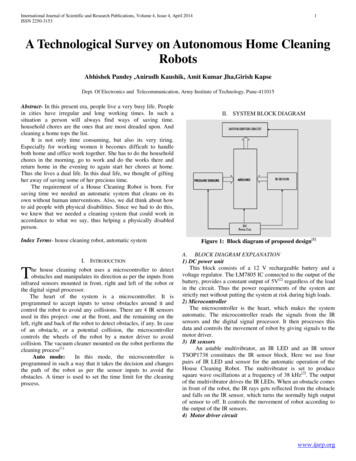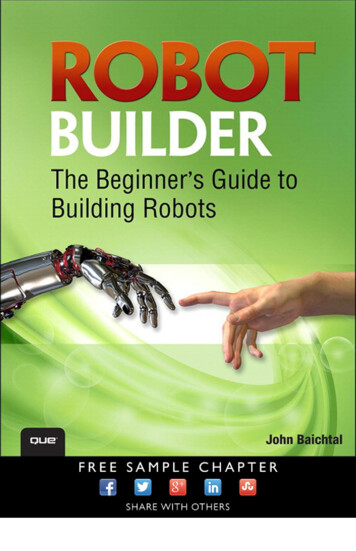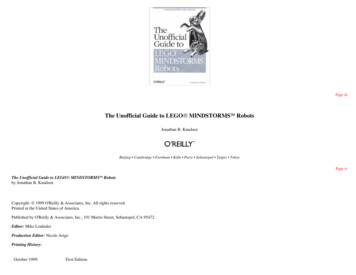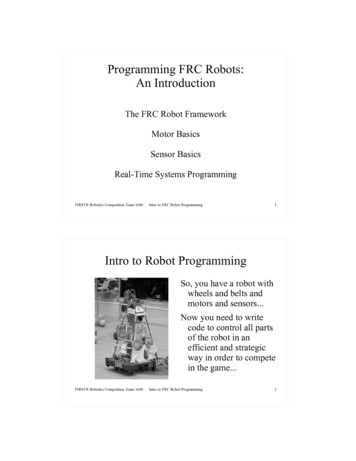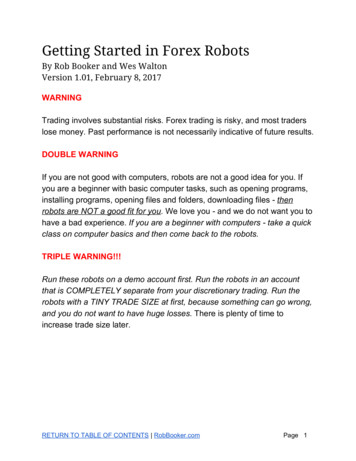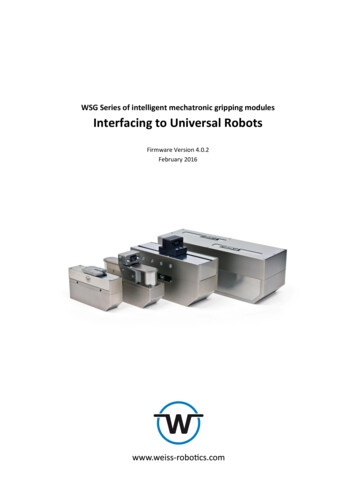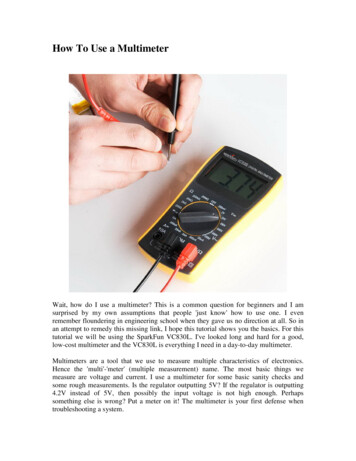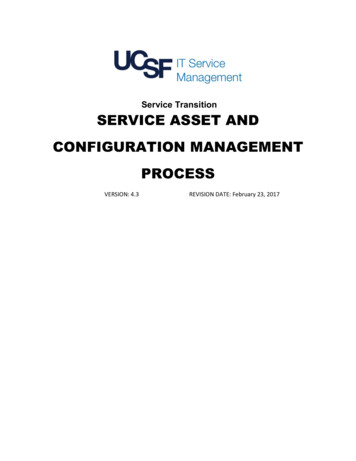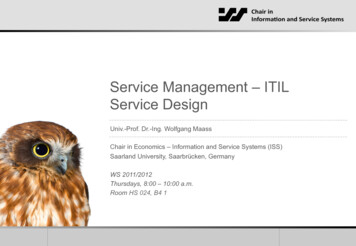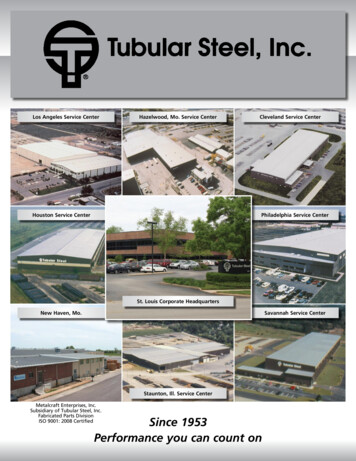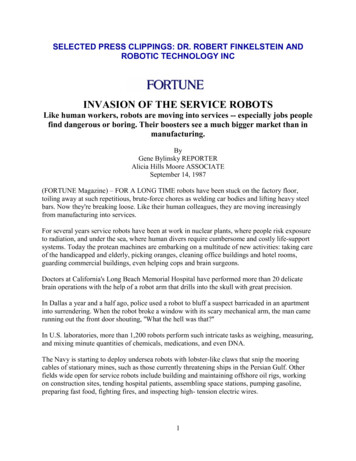
Transcription
SELECTED PRESS CLIPPINGS: DR. ROBERT FINKELSTEIN ANDROBOTIC TECHNOLOGY INCINVASION OF THE SERVICE ROBOTSLike human workers, robots are moving into services -- especially jobs peoplefind dangerous or boring. Their boosters see a much bigger market than inmanufacturing.ByGene Bylinsky REPORTERAlicia Hills Moore ASSOCIATESeptember 14, 1987(FORTUNE Magazine) – FOR A LONG TIME robots have been stuck on the factory floor,toiling away at such repetitious, brute-force chores as welding car bodies and lifting heavy steelbars. Now they're breaking loose. Like their human colleagues, they are moving increasinglyfrom manufacturing into services.For several years service robots have been at work in nuclear plants, where people risk exposureto radiation, and under the sea, where human divers require cumbersome and costly life-supportsystems. Today the protean machines are embarking on a multitude of new activities: taking careof the handicapped and elderly, picking oranges, cleaning office buildings and hotel rooms,guarding commercial buildings, even helping cops and brain surgeons.Doctors at California's Long Beach Memorial Hospital have performed more than 20 delicatebrain operations with the help of a robot arm that drills into the skull with great precision.In Dallas a year and a half ago, police used a robot to bluff a suspect barricaded in an apartmentinto surrendering. When the robot broke a window with its scary mechanical arm, the man camerunning out the front door shouting, ''What the hell was that?''In U.S. laboratories, more than 1,200 robots perform such intricate tasks as weighing, measuring,and mixing minute quantities of chemicals, medications, and even DNA.The Navy is starting to deploy undersea robots with lobster-like claws that snip the mooringcables of stationary mines, such as those currently threatening ships in the Persian Gulf. Otherfields wide open for service robots include building and maintaining offshore oil rigs, workingon construction sites, tending hospital patients, assembling space stations, pumping gasoline,preparing fast food, fighting fires, and inspecting high- tension electric wires.1
''We're seeing the birth of a big, new industry,'' says Joseph F. Engelberger, 62, the father ofindustrial robotics and the principal driving force behind service robots. ''Now that robots can bemobile and are starting to be able to see and feel, service jobs will eclipse the entiremanufacturing scene for robotics.''He envisions service robots soaring to 2 billion in annual sales in the U.S. by 1995, up fromabout 120 million today, mostly in undersea applications. (Like many such estimates in hightechnology, that 2- billion figure may well be optimistic.)By contrast, the U.S. market for industrial robots is expected to reach 370 million this year and 1 billion in the mid-1990s. As with almost any new technology, the major innovators aren't thebig, established companies -- in this case industrial-robot makers GM Fanuc Robotics, IBM, andCincinnati Milacron -- but small companies such as Engelberger's Transitions Research Corp.(TRC) of Bethel, Connecticut. (About the only exception is Westinghouse, which providesservice robots for nuclear utilities.)In the late 1950s Engelberger ignited the industrial robotics revolution by starting UnimationInc., the first robot company. TRC, a three-year-old privately held company with annual sales ofabout 1.5 million, is Engelberger's entry in the service-robot sweepstakes. The last time around,the Japanese in effect stole Engelberger's baby, the industrial robot. Because he could not affordto patent his robot in Japan, they ran away with it by copying and mass-producing the machines.Japanese robot makers such as Fanuc and Matsushita now control the world industrial-robotmarket.To keep the nascent service-robot industry from slipping into Japanese hands too, Engelbergerhas assembled an impressive lineup of big corporate backers for his projects, including Du Pont,3M, Johnson Wax, Electrolux AB, Maytag, and Emhart, a Connecticut conglomerate that had 2billion in sales last year. While Japan isn't exactly asleep, as of now it is behind in the underlyingtechnologies. A VISITOR TO TRC can be greeted by a squat three-foot-tall robot, a test- bed foran automatic vacuum cleaner, rolling by Engelberger's office with its electronic innards exposed.Research on the vacuum cleaner is sponsored by Electrolux, the big Swedish consumerelectronics concern. Designed to clean malls, supermarkets, factories, and airports withouthuman assistance, it will sell for about 20,000 when it goes on the market next year. Accordingto TRC, outside surveys show that a business with 35,000 square feet -- the size of a smallshopping mall -- to clean could use the machine economically.Other Engelberger robots include HelpMate, a nurse's aide that will deliver meal trays tobedridden hospital patients. Along the way, the wheeled robot will take elevators and negotiatehallways by itself, doubtless startling unwary visitors. HelpMate will be tested starting nextJanuary at the Danbury, Connecticut, hospital; Engelberger plans to put it into mass productionin 1989. It will sell for about 25,000 and will pay for itself in 2 1/2 years if it is used 24 hours aday, according to TRC-sponsored studies. Engelberger's ''ultimate robot,'' as he calls it, will be a 50,000 household helper -- assuming he can raise about 20 million to develop it. He sees thisrobot as a high-tech butler that would prepare meals, clean the house, cut the grass, clear thedriveway of snow, and even fix household appliances such as refrigerators and washingmachines. ''You'll get value and return on investment compared with hiring a practical nurse at2
9 an hour to help your old mother get around the house, as I do now, for example,'' Engelbergersays. One snag: He hasn't yet figured out how to teach it to make the beds. Not everyone agreesthat an all-purpose household robot will work.David Nitzan, director of the robotics lab at SRI International, thinks that it would make moresense technically to concentrate on single applications -- a bathroom-cleaning robot, for example.But no one disputes that service robots are expanding. Among other things, Nitzan and his groupare working on the vision system for a robot that would automatically sort packages for the U.S.Postal Service. Why the service robot surge? For one thing, progress in core technologies -vision, mobility, controls -- has been rapid.''It's a golden time,'' says William Whittaker, a senior scientist at the Carnegie Mellon UniversityRobotics Institute in Pittsburgh, a leading developer of service robots. ''A couple of years ago myfeeling was that there was very little insight into either what to do or how to do it. But now thosecontributing or enabling technologies are there for the most part. There's the magnitude of themarket, the potential and the inevitability of the technologies. It's as foregone as computing was20 years ago. It has the same feel to it.''There are demographic pressures as well. Many service-robot suppliers see the rapidly agingU.S. population as a huge, new market. People over 85 now make up the fastest-growingsegment of the elderly in the U.S., and 200,000 older Americans a year break their hips. SaysKaren G. Engelhardt, director of the Health and Human Sevices Robotics Laboratory at CarnegieMellon: ''Never before have we seen a technology with such promise and potential to help thislarge and growing population in ways they never could be helped before.''BECAUSE SERVICE ROBOTS are often able to make repairs under hazardous conditions fasterthan people can, for example, they may deliver the increased productivity that has generallyeluded the service sector. Shortages of service workers such as nurses are another force drivingthe advent of service robots. So are corporate policies and regulatory pressures against placingworkers in dangerous settings.Since 1971, for instance, 54 deep-sea divers have been lost in North Sea offshore oil and gasoperations. The shift toward robot submersibles has turned a lot of divers into shipboard robotoperators -- a much safer occupation. In nuclear plants, robots toil for hours at a time in highlyradioactive areas in place of hundreds of employees, called jumpers or glowboys, who worked inshort relays so as to minimize their exposure. In space, robots can significantly speed assemblyof big structures like NASA's projected space station for the 1990s.In those three settings -- in nuclear plants, under the sea, and in space -- cost savings are a bigfactor as well. Supporting deep-sea divers and astronauts working outside their spacecraft cancost up to 100,000 an hour. When a nuclear plant shuts down, replacing the lost electricity cancost a utility an estimated 500,000 a day; robots have already helped shorten those shutdowns.The military, whose primary concern isn't economics, sees in the new robots a way to maintainhigh-tech superiority over more numerous enemy armies on a battlefield.3
The Pentagon is spending hundreds of millions of dollars a year to develop smallunmanned tanks, intelligent robotic undersea vehicles, and flying spy robots that fill thegap between airplanes and satellites. Robert Finkelstein, president of Robotic TechnologyInc. of Potomac, Maryland, who works closely with the Pentagon, says research anddevelopment outlays for robot systems will soar to 3 billion a year by 1995.Both robot builders and users now recognize that the new robots can do a lot of things humanscan't. Anthropomorphism -- having robots imitate human activities -- has fascinated robot buffsever since the Czech playwright Karel Capek introduced the word ''robot'' into the lexicon. In hispopular 1921 play R.U.R., for Rossum's Universal Robots, Capek made robots look likemechanical counterparts of man. He derived the word from the Czech robota, which means work-- including forced labor.Anthropomorphism is appealing, but many robot builders think it is usually a wrong track inrobotics because it fails to take advantage of some remarkable man-made devices andtechnologies. Although highly dextrous, the human arm and wrist, for instance, cannot twistcompletely around. A robot hand can. ''We can try all we want to imitate mammals,'' says TRC'sEngelberger, ''but no animal has a built-in ball bearing.'' A robot arm that rotates in all possibledirections, for example, is more useful than an imitation human arm that is limited by its joints.In a remarkable demonstration of robotic agility, a nuclear-plant robot built by Odetics Inc. ofAnaheim, California, not only walks on six legs but also can extend itself from a height of fivefeet to a total of 14 feet, becoming a kind of a mechanical giraffe. It can hang from ledges insidenuclear plants, working upside down. By automatically changing the gripper in its hand it can doa variety of tasks, from changing light bulbs -- a huge job in a nuclear plant -- to lifting objectsthat weigh up to 300 pounds. Similarly, surveillance robots can do things a human guard cannot.Thanks to microwave vision, they can see through nonmetallic walls and in the dark can spot anintruder as far as 130 feet away.Most robots in use today in space, under the sea, and in nuclear plants are operated from adistance by human workers as extensions of themselves. More often than not, the robots aretethered by a cable to the control station; the cable transmits electric power and serves as acommunication link to the robot. Robot builders call this telerobotics, or teleoperation -- anextension of human sensing and manipulating capability.WHILE TELEOPERATION obviously keeps people out of hazardous environments, it hasdrawbacks. Operators can have trouble controlling remote robots and monitoring exactly whatthey're doing -- for instance, when they're working undersea in murky waters. For greaterversatility, a robot should work on its own, with minimal human supervision.Says Robotic Technology's Finkelstein: ''The essence now is intelligent control systems. Thetechnology for teleoperation is here now. The technology for automatic operations is beingdeveloped. If you have a tank as smart as an ant that knows how to tell an enemy from afriend, that could revolutionize warfare.''4
Currently, the U.S. Army is developing a walking truck to traverse roadless terrain, a contraptionwith fat, bent legs and a wriggling body that make it look like an immense, unearthly insect. Thegrowing military applications of robots promise civilian fallout that could pay off for companiesbig and small. For example, military work on robots that navigate by themselves could beapplied to trucks, automobiles, and factory vehicles.Early designs for NASA's space station assembly robot, called Flight Telerobotic Servicer (FTS),resemble a refrigerator with a flat head and four arms. FTS will be a hybrid between a telerobotand a fully autonomous machine. An astronaut can run it in two ways. In the teleoperated mode,the physical motions of an astronaut's hand will be reproduced by the robot's mechanical arms,which multiply the astronaut's force. The astronaut will work in shirtsleeves inside the spacestation; the robot will be outside. Alternatively, the robot could operate ''teleautonomously.'' Theastronaut would transmit complex commands for it to interpret and execute. The astronaut, forinstance, could command the robot to repair a nearby spacecraft. The robot would dock with thesatellite and do its job without any further commands from its operator, who would watch therobot on his TV screen and intervene if needed. Six NASA contractors -- Westinghouse,Grumman, Fairchild, Lockheed, Martin Marietta, and United Technologies -- have just submittedpreliminary design plans for the FTS robot.Giulio Varsi, manager of automation and robotics for NASA's space station office, talksenthusiastically about developing space robots that ''learn as they go along'' -- intelligentautomatons with sufficient vision and a fine sense of touch that can modify their actions ascircumstances change. Such technologies would help improve earth-based service robots. Theinitial FTS robot will cost about 200 million, in part because of its highly complex software, butsubsequent versions could probably be produced for about 10 million apiece, Varsi says.THE MOST SURPRISING demonstration of robot autonomy so far will take place as early asOctober at New Hampshire's Lake Winnipesaukee. In a game of wits, government andUniversity of New Hampshire researchers will pit two untethered undersea robot craft workingtogether against men in boats, who will try to detect the robots with sonar and other instruments.For their part the robots will work in tandem, using microprocessors guided by artificialintelligence software. The robot craft will attempt to elude their human pursuers by sacrificingone robot and having the other escape with TV pictures and other data it has gathered. The key tomaking robots smarter lies in computer power that can enhance their intelligence, which is so farrather dim. Carnegie Mellon's Whittaker says that some of the service robots his institute hasbuilt have only reached the ''intelligence of a worm.'' Robots as brainy as the pair in Star Wars,the timid android C3PO and its barrel-shaped electronic sidekick, R2D2, are at least 50 yearsaway.One reason: Progress toward giving robots humanlike sight and hands has been excruciatinglyslow. In the case of sight, digital computers have trouble recognizing patterns that people spotalmost intuitively. After about a decade of work, researchers at Stanford University who aretrying to impart vision to robots have just scored what they consider an impressive victory. Theirvision system can recognize about two dozen different objects -- airplanes of varying shapes, forexample -- as belonging to a single class. A University of Utah- MIT project in progress forseven years has yet to produce a fully workable hand, although researchers have constructed a5
computerized prototype with tendon-like wires and four fingers run by 32 miniature motors.Both research teams have come to appreciate the awesome complexity of human senses andinformation processing.Says Stanford researcher Thomas O. Binford: ''The retina of one eye has roughly 100 millionspecialized vision cells and four layers of neurons, all capable of doing about ten billioncalculations a second.'' All told, about 60% of the brain's cortex, the so- called thinking cap ontop of the brain, is involved in handling visual information -- a computational task that it wouldtake 100,000 Cray supercomputers to handle, Binford estimates. If researchers can get robots tosee clearly and to understand where they are -- another classic problem -- that would makepossible seeing-eye robots, among other things.The elusiveness of perfection does not deter the practical types, however. ''University researcherssometimes unnecessarily complicate things,'' says Engelberger. ''We take bits and pieces ofavailable technology -- ultrasound, infrared, TV cameras -- and we tell our robots beforehandwhere to go.''ENGELBERGER PLANS to get around the ''Where am I?'' problem in his cleaning robot byusing what he calls the Hansel and Gretel concept. In a typical operation, the robot begins bycircling the perimeter of a room, bouncing sonar off the walls to locate itself. As the robot goesalong, the Hansel and Gretel scheme comes into play. Those fairy tale tots marked their path inthe forest by leaving a trail of bread crumbs to guide them back out. Birds ate the crumbs, ofcourse, or there wouldn't have been a story. Each time Engelberger's cleaner makes a circuit, itwill drop tiny pieces of fluorescent paper -- ''bread crumb equivalents,'' Engelberger calls them -to one side, creating a parallel, inner circle that it will follow the next time around. It's much likemowing a lawn in a continuous spiral from the outside in. As the robot follows the path, itsscrubbing brushes will clean up the old trail just as Hansel and Gretel's birds did. This or similarapproaches are a lot easier than trying to build up a comprehensive picture of the world inside arobot's brain. As for hands: Many of today's robots can automatically change their ''endeffectors,'' tools that take the place of fingers to perform different jobs.Odetics, the Anaheim company that builds the walking robot, has just developed a hand that cangrip a wider variety of objects and shapes -- from a pencil to a railroad tie -- than other models. Ithas two thumbs and one finger; the thumbs can rotate to grasp a payload, just as human thumbscan. Unlike a human hand or the University of Utah-MIT design, the Odetics hand requires no''tendons'' in the arm or wrist to provide the power to move.AT CARNEGIE MELLON'S Robotics Institute, Bill Whittaker sees the next important advancesin service robots coming not in the basic technologies that make the robots possible but incombining them into working robots. Putting that view into practice, his institute has beenturning out an impressive flock of robots. One has been used to decontaminate radioactive partsof the disabled Three Mile Island reactor. Another, a hulking brute of a machine about the size ofa compact car, has four wheels and four stiff legs to walk with if its steering or the motors thatdrive its wheels fail. It can work with a hook, a crowbar, a shovel, a saw, a water-jet cutter, andother tools it carries. Stanford University robot researchers have helped bring to fruition animpressive robot system that takes care of at least 13 needs of quadriplegics, from preparing6
canned soup and serving it to brushing their teeth afterward. During a recent demonstration of itsremarkable skills at the Palo Alto Veterans Administration Medical Center, the robot greetedvisitors with a brisk ''Hi, Earthlings!'' and proceeded to put on an impressive show. Because theresearch has been financed with fed
SELECTED PRESS CLIPPINGS: DR. ROBERT FINKELSTEIN AND ROBOTIC TECHNOLOGY INC INVASION OF THE SERVICE ROBOTS Like human workers, robots are moving into services -- especial
